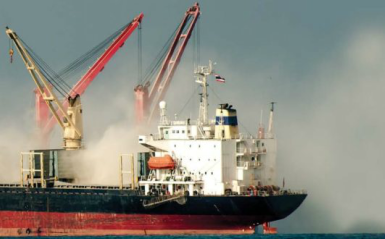
The Swedish P&I Club has published an excellent quick reference guide about the causes and prevention of cargo fires and explosions onboard. The guide focuses on self-heating. It explains the principles of self-heating as well as investigating several types of cargo fires and explosions, including those in vessels such as bulk cargoes, containers and tankers.
When a fire breaks out on board a vessel there is no fire service ready to assist in extinguishing it. So it is up to the crew themselves to manage and deal with the issue. The consequences can be catastrophic. All those who have worked on board a vessel are aware of the difficulties involved with managing a fire and the crucial importance of fire prevention.
Causes of self-heating
– Availability of oxygen: For example, with many bulk coal cargoes the holds need to be kept closed and sealed. This restricts the access of air (oxygen) to the cargo which restricts the oxidation reactions, so that temperatures do not rise to problematic levels.
– Availability of water: For example, DRI needs to be kept dry so that it cannot react with water. If water does enter holds containing DRI it can start a self-heating reaction which can then worsen, leading to oxidation reactions with air and then severe heating.
– Reactivity of cargo: Some cargoes need to be ‘aged’ by exposure to air/oxygen so that the most easily oxidised parts have reacted before loading. This means that the rate of oxidation of the cargo is reduced and so self-heating is less likely.
– Ability of air/oxygen to diffuse into the cargo: Self-heating due to oxidation can only progress to a problematic level if enough oxygen can pass into the cargo to produce heat that cannot be dissipated. For example, some cargoes, such as activated carbon, may need to be carried in hermetically sealed bags to stop air/oxygen contacting the cargo.
– Temperature of cargo: Reactions are faster at higher temperatures, so the loading temperature of some cargoes needs to be restricted so that oxidation rates are not too fast. For example, bulk coal needs to be at a maximum temperature of 55°C when loading.
– Size of the body of cargo: Heat is dissipated less effectively from a larger body, for example, some cargoes have package size restrictions or maximum container load restrictions.
Other causes of cargo fires and explosions
– Cargo lights: Cargo lights in holds need to be properly isolated before cargo is loaded. This is best done by removing fuses or other physical links in the electrical circuits so that the lights cannot be switched on by mistake.
– Smoking and hot work: Smoking and hot work need to be properly controlled. Control of smoking can be difficult where stevedores are working on board. Hot work permits need to be properly considered, not just a ‘tick box’ exercise.
– Cars and other vehicles: Cars and other vehicles carried on board ships present some risk of fire. Risks include cargo shifting in heavy weather and used vehicles in poor condition giving rise to electrical faults.
– Fumigants: Fumigants can cause fire or explosion, particularly if there is an excessive amount of fumigant in one place; or if the fumigant is in contact with liquid water e.g. from sweating or condensation. In these situations the fumigant can react too quickly, evolving excessive heat or explosive gas/vapour. Fumigants must be correctly applied by qualified personnel.
Read the Swedish P&I Club guide to fire: Swedish P&I Club guide to fire
